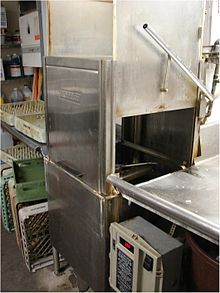Dishwasher


The word dishwasher means either the person who washes (cleans) dishes or a machine that does the same thing. A person could wash dishes either by hand or by operating a dishwashing machine.
History[change | change source]
Joel Houghton registered the first patent for a mechanical dishwasher in1850. The machine was made of wood. A hand crank was used, while water was sprayed onto the dishes.[1] The device was both slow and unreliable. In 1865, L.A. Alexander was granted a patent for a similar device, that used a hand-cranked rack system.[2] Neither device was practical or widely accepted. Some historians say that one of the main obstancles was that people valued women for the effort they put into the houseork, rather than looking at the resuts; making household chores easier was perceived by some to reduce their value.[3]
The most successful of the hand-powered dishwashers was invented in 1886 by Josephine Cochrane together with mechanic George Butters in Cochrane's tool shed in Shelbyville, Illinois.[4] Cochrane, who was a wealthy socialite, wanted to protect her china while it was being washed.[5] Their invention was unveiled at the 1893 World's Fair in Chicago under the name of Lavadora. The name was later changed to Lavaplatos as another machine invented in 1858 already held that name. Cochrane's inspiration was her frustration at the damage to her good china that occurred when her servants handled it during cleaning.[6]
References[change | change source]
- ↑ U.S. Patent 7,365
- ↑ U.S. Patent 51,000A
- ↑ "What Does It Take To Get Us To Try Something New?". The Indicator from Planet Money. NPR. 26 May 2021.
- ↑ U.S. Patent 355,139
- ↑ Blattman, Elissa (2013), Three Every-day Items Invented by Women, National Women's History Museum
- ↑ "Josephine Cochrane | Lemelson-MIT Program".
